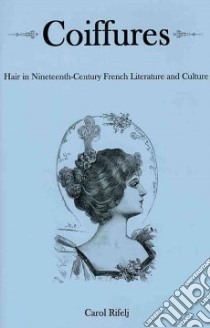Coiffures - 9780874130997
Un libro in lingua di Carol Rifelj edito da Associated Univ Pr, 2010
- € 49.90
- Il prezzo è variabile in funzione del cambio della valuta d’origine
Balzac claimed that toilettes were the expression of society. Coiffures describes the historical and cultural practices associated with women's hairstyles, hair care, and hair art in nineteenth-century France. Hair also has profound symbolic significance. Lying on the border between life and death, it grows, but does not feel. It can be shaped and altered in manifold ways; it marks sexual identity; it can be wild and erotic or made docile by hairdressing. Literary works are inevitably informed by social and cultural practices and those of this period make extensive use of the meanings of hair, Coiffures shows how a wide range of literary works incorporate its manifold aspects, and it examines particular texts in detail, including novels by Balzac, Sand, Flaubert, Zola, Gautier, Maupassant, and Rodenbach.
In the nineteenth century, as Paris became the world center of fashion, it was also the capital of hair: changing styles, the commerce in false hairpieces, and products for hair care played an important part in the expansion of consumer culture. In addition, this was the age of sentimental and commemorative jewelry, when pictures made of hair and exchanging locks were common. Coiffures describes these practices, drawing extensively on nineteenth-century advice manuals for women, the fashion press, and contemporary journals and books for hairdressers, as well as the secondary literature on these topics.
Every one of the major French novelists wrote works in which women's hair figures prominently, in a variety of ways. The Realist novelists in particular devote great attention to the physical traits and dress of their characters and provide a wealth of descriptive detail, in which hair is often a key element. In the literary portraits that often present characters, hair may indicate social characteristics like class, age, attractiveness, fashion sense, propriety, or impropriety. Or it may convey personality, particularly for writers influenced by the pseudoscience of physiognomy. Hair also contributes to plot, especially when it is cut or when it comes down: a crucial part of the story may be told through what happens to a character's hair.
Coiffures puts these works into their cultural context in order to illuminate their meaning and to address many questions. What are the terms that refer to hair, and what are their connotations? How does hair intersect with plots, characters, and themes? What value is assigned to different hair colors? What are the social and literary implications of cut hair? How does hair figure sex and sexuality? Does women's hair evoke weakness or power? How does hair contribute to the discourse on literature and the body? Examining these questions shows that hair is remarkably malleable in the hands of the great nineteenth-century novelists.
Informazioni bibliografiche
- Titolo del Libro in lingua: Coiffures
- Sottotitolo: Hair in Nineteenth-century French Literature and Culture
- Lingua: English
- Autore: Carol Rifelj
- Editore: Associated Univ Pr
- Collana: Associated Univ Pr (Hardcover)
- Data di Pubblicazione: 31 Gennaio '10
- Genere: LITERARY CRITICISM
- Argomenti : French literature 19th century History and criticism Hair in literature Hair in popular culture
- Pagine: 297
- ISBN-10: 0874130999
- EAN-13: 9780874130997


